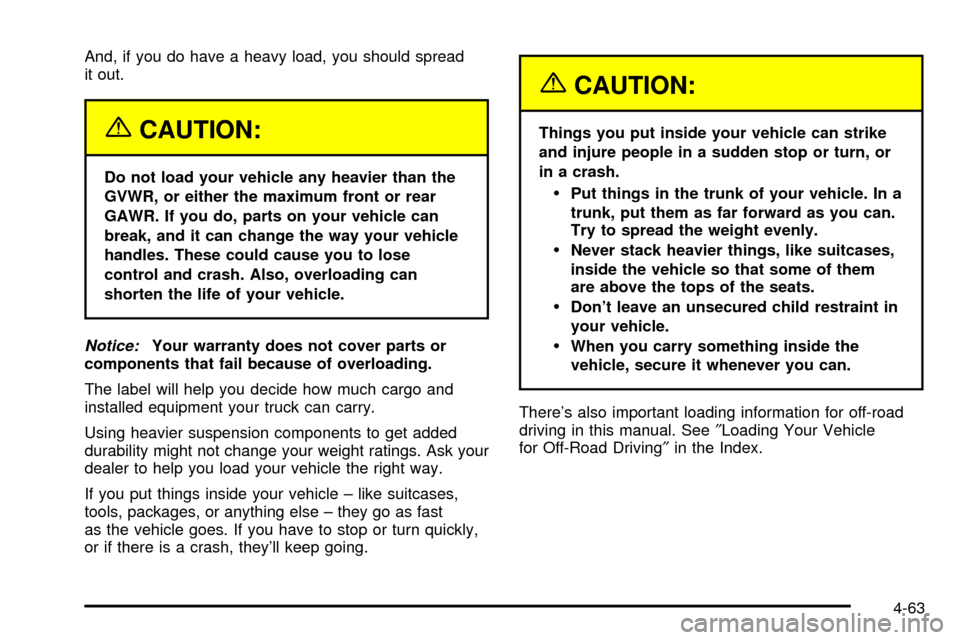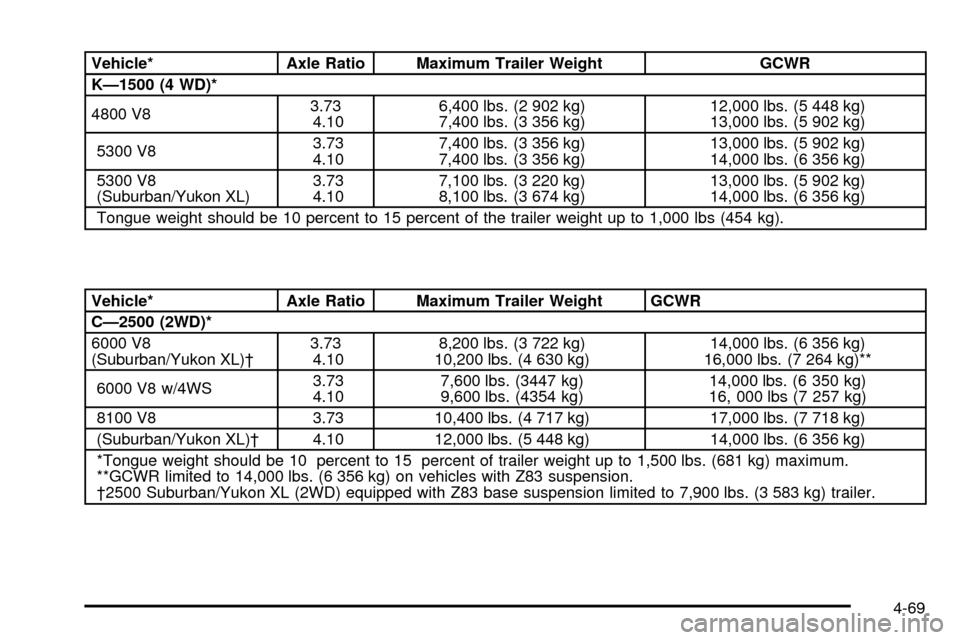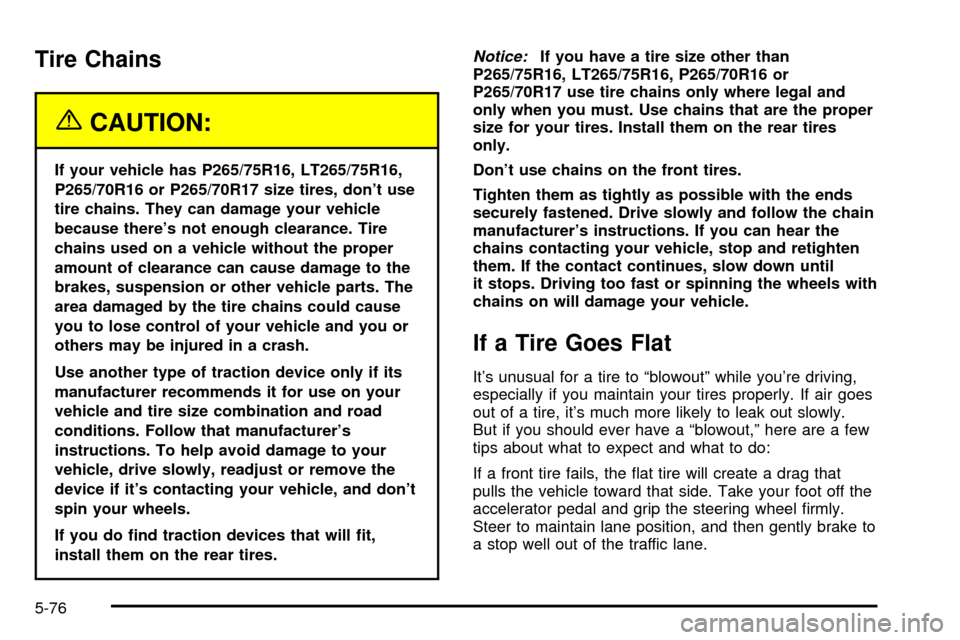2003 CHEVROLET SUBURBAN suspension
[x] Cancel search: suspensionPage 233 of 552

SERVICE 4WD
If a problem occurs with the four wheel drive system
this message will appear on the DIC. If this message
appears, stop as soon as possible and turn off the
vehicle. Restart the vehicle and check for the message
on the DIC display. If the message is still displayed,
or appears again when you begin driving, the four wheel
drive system needs service. Press the select button to
acknowledge the message.
SERVICE RIDE CONTROL
If a problem occurs with the suspension system, this
message will appear on the DIC. If the message
appears turn off the vehicle. Restart the vehicle and
check for the message on the DIC display. If the
message is still displayed, or appears again when you
begin driving, the ride control needs service. Press
the select button to acknowledge the message.
RIGHT REAR DOOR AJAR
If the passenger's side rear door is not fully closed, this
message will appear on the display and you will hear
a chime. Stop and turn off the vehicle, check the door for
obstacles, and close the door again. Check to see if
the message still appears on the DIC. Press the select
button to acknowledge the message and clear it
from the DIC display.
SERVICE STABILITY
If you ever see the SERVICE STABILITY message, it
means there may be a problem with your
Stabilitrak
žsystem. If you see this message try to reset
the system (stop; turn off the engine; then start the
engine again). If the SERVICE STABILITY message still
comes on, it means there is a problem. You should
see your dealer for service. The vehicle is safe to drive,
however, you do not have the bene®t of Stabilitrak
ž,
so reduce your speed and drive accordingly. Press the
select button to acknowledge the message and clear
it from the DIC display.
SERVICE TIRE MONITOR
This message will be displayed if one or more of the tire
monitor sensors have malfunctioned, or if all of the
tire monitor sensors have not been programmed
successfully. Press the select button or reset stem, to
clear it from the display. The message will reappear
at each ignition cycle until the system has been
serviced.
3-69
Page 334 of 552

After Off-Road Driving
Remove any brush or debris that has collected on the
underbody, chassis or under the hood. These
accumulations can be a ®re hazard.
After operation in mud or sand, have the brake linings
cleaned and checked. These substances can cause
glazing and uneven braking. Check the body structure,
steering, suspension, wheels, tires and exhaust
system for damage. Also, check the fuel lines and
cooling system for any leakage.
Your vehicle will require more frequent service due to
off-road use. Refer to the Maintenance Schedule
for additional information.
Driving at Night
Night driving is more dangerous than day driving. One
reason is that some drivers are likely to be impaired Ð by
alcohol or drugs, with night vision problems, or by fatigue.
Here are some tips on night driving.
·Drive defensively.
·Don't drink and drive.
·Adjust your inside rearview mirror to reduce the
glare from headlamps behind you.
4-40
Page 357 of 552

And, if you do have a heavy load, you should spread
it out.
{CAUTION:
Do not load your vehicle any heavier than the
GVWR, or either the maximum front or rear
GAWR. If you do, parts on your vehicle can
break, and it can change the way your vehicle
handles. These could cause you to lose
control and crash. Also, overloading can
shorten the life of your vehicle.
Notice:Your warranty does not cover parts or
components that fail because of overloading.
The label will help you decide how much cargo and
installed equipment your truck can carry.
Using heavier suspension components to get added
durability might not change your weight ratings. Ask your
dealer to help you load your vehicle the right way.
If you put things inside your vehicle ± like suitcases,
tools, packages, or anything else ± they go as fast
as the vehicle goes. If you have to stop or turn quickly,
or if there is a crash, they'll keep going.
{CAUTION:
Things you put inside your vehicle can strike
and injure people in a sudden stop or turn, or
in a crash.
·Put things in the trunk of your vehicle. In a
trunk, put them as far forward as you can.
Try to spread the weight evenly.
·Never stack heavier things, like suitcases,
inside the vehicle so that some of them
are above the tops of the seats.
·Don't leave an unsecured child restraint in
your vehicle.
·When you carry something inside the
vehicle, secure it whenever you can.
There's also important loading information for off-road
driving in this manual. See²Loading Your Vehicle
for Off-Road Driving²in the Index.
4-63
Page 358 of 552

Level Control
Automatic Level Control
The automatic level control rear suspension is available
on C/K 1500 vehicles and comes as a part of the
AutorideŸ suspension.
This type of level control is fully automatic and will provide
a better leveled riding position as well as better handling
under a variety of passenger and loading conditions. An
air compressor connected to the rear shocks will raise or
lower the rear of the vehicle to maintain proper vehicle
height. The system is activated when the ignition key is
turned to RUN and will automatically adjust vehicle height
thereafter. The system may exhaust (lower vehicle
height) for up to ten minutes after the ignition key has
been turned off. You may hear the air compressor
operating when the height is being adjusted.
If a self-equalizing hitch is being used, it is
recommended to allow the shocks to in¯ate, thereby
leveling the vehicle prior to adjusting the hitch.
AutorideŸ
The AutorideŸ feature will provide a superior vehicle
ride and handling under a variety of passenger and
loading conditions.
The system is fully automatic and uses a computer
controller to continuously monitor vehicle speed, wheel
to body position, lift/dive and steering position of the
vehicle. The controller then sends signals to each shock
absorber to independently adjust the damping level to
provide the optimum vehicle ride.
AutorideŸ also interacts with the tow/haul switch that,
when engaged, will provide additional control of the
shock absorbers. This additional control results in better
ride and handling characteristics when the vehicle is
loaded or towing a trailer. See
Tow/Haul Mode Light on
page 3-52for more information.
4-64
Page 363 of 552

Vehicle* Axle Ratio Maximum Trailer Weight GCWR
KÐ1500 (4 WD)*
4800 V83.73
4.106,400 lbs. (2 902 kg)
7,400 lbs. (3 356 kg)12,000 lbs. (5 448 kg)
13,000 lbs. (5 902 kg)
5300 V83.73
4.107,400 lbs. (3 356 kg)
7,400 lbs. (3 356 kg)13,000 lbs. (5 902 kg)
14,000 lbs. (6 356 kg)
5300 V8
(Suburban/Yukon XL)3.73
4.107,100 lbs. (3 220 kg)
8,100 lbs. (3 674 kg)13,000 lbs. (5 902 kg)
14,000 lbs. (6 356 kg)
Tongue weight should be 10 percent to 15 percent of the trailer weight up to 1,000 lbs (454 kg).
Vehicle* Axle Ratio Maximum Trailer Weight GCWR
CÐ2500 (2WD)*
6000 V8
(Suburban/Yukon XL)²3.73
4.108,200 lbs. (3 722 kg)
10,200 lbs. (4 630 kg)14,000 lbs. (6 356 kg)
16,000 lbs. (7 264 kg)**
6000 V8 w/4WS3.73
4.107,600 lbs. (3447 kg)
9,600 lbs. (4354 kg)14,000 lbs. (6 350 kg)
16, 000 lbs (7 257 kg)
8100 V8 3.73 10,400 lbs. (4 717 kg) 17,000 lbs. (7 718 kg)
(Suburban/Yukon XL)² 4.10 12,000 lbs. (5 448 kg) 14,000 lbs. (6 356 kg)
*Tongue weight should be 10 percent to 15 percent of trailer weight up to 1,500 lbs. (681 kg) maximum.
**GCWR limited to 14,000 lbs. (6 356 kg) on vehicles with Z83 suspension.
²2500 Suburban/Yukon XL (2WD) equipped with Z83 base suspension limited to 7,900 lbs. (3 583 kg) trailer.
4-69
Page 364 of 552

Vehicle* Axle Ratio Maximum Trailer Weight GCWR
KÐ2500 (4WD)*
6000 V8
(Suburban/Yukon XL)²3.73
4.107,600 lbs. (3 447 kg)
9,600 lbs. (4 354kg)14,000 lbs. (6 356 kg)
16,000 lbs. (7 264 kg)**
6,000 V8 w/4WS3.73
4.107,300 lbs. (3 311 kg)
9,300 lbs. (4 218 kg)14,000 lbs. (6 350 kg)
16, 000 lbs (7 257 kg)
8100 V83.73
4.1010,100 lbs. (4 581 kg)
12,000 lbs. (5 448 kg)17,000 lbs. (7 718 kg)
19,000 lbs. (8 626 kg)
*Tongue weight should be 10 percent to 15 percent of trailer weight up to 1,500 lbs. (681 kg)
**GCWR limited to 14,000 lbs. (6 356 kg) on vehicles with Z83 suspension.
²2500 Suburban/Yukon XL (4WD) equipped with Z83 base suspension limited to 7,900 lbs. (3 586 kg) trailer.
The Gross Combination Weight Rating (GCWR) is the
total allowable weight of the completely loaded
vehicle and trailer including any passengers, cargo,
equipment and conversions. The GCWR for your vehicle
should not be exceeded.
You can ask your dealer for our trailering information or
advice, or you can write us at the address listed in
your Warranty and Owner Assistance Information
Booklet.In Canada, write to:
General Motors of Canada Limited
Customer Communication Centre, 163-005
1908 Colonel Sam Drive
Oshawa, Ontario L1H 8P7
4-70
Page 452 of 552

Tire Chains
{CAUTION:
If your vehicle has P265/75R16, LT265/75R16,
P265/70R16 or P265/70R17 size tires, don't use
tire chains. They can damage your vehicle
because there's not enough clearance. Tire
chains used on a vehicle without the proper
amount of clearance can cause damage to the
brakes, suspension or other vehicle parts. The
area damaged by the tire chains could cause
you to lose control of your vehicle and you or
others may be injured in a crash.
Use another type of traction device only if its
manufacturer recommends it for use on your
vehicle and tire size combination and road
conditions. Follow that manufacturer's
instructions. To help avoid damage to your
vehicle, drive slowly, readjust or remove the
device if it's contacting your vehicle, and don't
spin your wheels.
If you do ®nd traction devices that will ®t,
install them on the rear tires.
Notice:If you have a tire size other than
P265/75R16, LT265/75R16, P265/70R16 or
P265/70R17 use tire chains only where legal and
only when you must. Use chains that are the proper
size for your tires. Install them on the rear tires
only.
Don't use chains on the front tires.
Tighten them as tightly as possible with the ends
securely fastened. Drive slowly and follow the chain
manufacturer's instructions. If you can hear the
chains contacting your vehicle, stop and retighten
them. If the contact continues, slow down until
it stops. Driving too fast or spinning the wheels with
chains on will damage your vehicle.
If a Tire Goes Flat
It's unusual for a tire to ªblowoutº while you're driving,
especially if you maintain your tires properly. If air goes
out of a tire, it's much more likely to leak out slowly.
But if you should ever have a ªblowout,º here are a few
tips about what to expect and what to do:
If a front tire fails, the ¯at tire will create a drag that
pulls the vehicle toward that side. Take your foot off the
accelerator pedal and grip the steering wheel ®rmly.
Steer to maintain lane position, and then gently brake to
a stop well out of the traffic lane.
5-76
Page 499 of 552

Maintenance Schedule......................................6-2
Introduction...................................................6-2
Your Vehicle and the Environment....................6-2
Maintenance Requirements..............................6-2
How This Section is Organized.........................6-3
Part A: Scheduled Maintenance Services...........6-4
Using Your Maintenance Schedule....................6-4
Scheduled Maintenance...................................6-5
Part B: Owner Checks and Services................6-11
At Each Fuel Fill..........................................6-11
At Least Once a Month.................................6-11
At Least Twice a Year...................................6-12
At Least Once a Year...................................6-13Part C: Periodic MaintenanceInspections.........6-16
Steering and Suspension Inspection................6-16
Exhaust System Inspection............................6-16
Fuel System Inspection..................................6-16
Engine Cooling System Inspection...................6-17
Transfer Case and Front Axle (Four-Wheel
Drive) Inspection.......................................6-17
Brake System Inspection................................6-17
Part D: Recommended Fluids and Lubricants. . . .6-18
Part E: Maintenance Record...........................6-20
Section 6 Maintenance Schedule
6-1